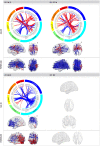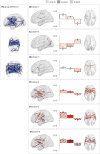Functional connectome differences in individuals with hallucinations across the psychosis continuum
- PMID: 33441965
- PMCID: PMC7806763
- DOI: 10.1038/s41598-020-80657-8
Functional connectome differences in individuals with hallucinations across the psychosis continuum
Erratum in
-
Author Correction: Functional connectome differences in individuals with hallucinations across the psychosis continuum.Sci Rep. 2021 Apr 14;11(1):8540. doi: 10.1038/s41598-021-87849-w. Sci Rep. 2021. PMID: 33854185 Free PMC article. No abstract available.
Abstract
Hallucinations may arise from an imbalance between sensory and higher cognitive brain regions, reflected by alterations in functional connectivity. It is unknown whether hallucinations across the psychosis continuum exhibit similar alterations in functional connectivity, suggesting a common neural mechanism, or whether different mechanisms link to hallucinations across phenotypes. We acquired resting-state functional MRI scans of 483 participants, including 40 non-clinical individuals with hallucinations, 99 schizophrenia patients with hallucinations, 74 bipolar-I disorder patients with hallucinations, 42 bipolar-I disorder patients without hallucinations, and 228 healthy controls. The weighted connectivity matrices were compared using network-based statistics. Non-clinical individuals with hallucinations and schizophrenia patients with hallucinations exhibited increased connectivity, mainly among fronto-temporal and fronto-insula/cingulate areas compared to controls (P < 0.001 adjusted). Differential effects were observed for bipolar-I disorder patients with hallucinations versus controls, mainly characterized by decreased connectivity between fronto-temporal and fronto-striatal areas (P = 0.012 adjusted). No connectivity alterations were found between bipolar-I disorder patients without hallucinations and controls. Our results support the notion that hallucinations in non-clinical individuals and schizophrenia patients are related to altered interactions between sensory and higher-order cognitive brain regions. However, a different dysconnectivity pattern was observed for bipolar-I disorder patients with hallucinations, which implies a different neural mechanism across the psychosis continuum.
Conflict of interest statement
The authors declare no competing interests.
Figures



Similar articles
-
Modular-Level Functional Connectome Alterations in Individuals With Hallucinations Across the Psychosis Continuum.Schizophr Bull. 2022 May 7;48(3):684-694. doi: 10.1093/schbul/sbac007. Schizophr Bull. 2022. PMID: 35179210 Free PMC article.
-
Functional Connectivity of the Striatum in Schizophrenia and Psychotic Bipolar Disorder.Biol Psychiatry Cogn Neurosci Neuroimaging. 2019 Nov;4(11):956-965. doi: 10.1016/j.bpsc.2019.05.017. Epub 2019 Jun 12. Biol Psychiatry Cogn Neurosci Neuroimaging. 2019. PMID: 31399394 Free PMC article.
-
Global brain connectivity alterations in patients with schizophrenia and bipolar spectrum disorders.J Psychiatry Neurosci. 2016 Aug;41(5):331-41. doi: 10.1503/jpn.150159. J Psychiatry Neurosci. 2016. PMID: 26854755 Free PMC article.
-
Resting-state functional connectivity in individuals with bipolar disorder during clinical remission: a systematic review.J Psychiatry Neurosci. 2018 Aug;43(5):298-316. doi: 10.1503/jpn.170175. J Psychiatry Neurosci. 2018. PMID: 30125243 Free PMC article.
-
Anatomical dysconnectivity in bipolar disorder compared with schizophrenia: A selective review of structural network analyses using diffusion MRI.J Affect Disord. 2017 Feb;209:217-228. doi: 10.1016/j.jad.2016.11.015. Epub 2016 Nov 17. J Affect Disord. 2017. PMID: 27930915 Review.
Cited by
-
Modular-Level Functional Connectome Alterations in Individuals With Hallucinations Across the Psychosis Continuum.Schizophr Bull. 2022 May 7;48(3):684-694. doi: 10.1093/schbul/sbac007. Schizophr Bull. 2022. PMID: 35179210 Free PMC article.
-
Auditory hallucinations across the psychosis spectrum: Evidence of dysconnectivity involving cerebellar and temporal lobe regions.Neuroimage Clin. 2021;32:102893. doi: 10.1016/j.nicl.2021.102893. Epub 2021 Nov 24. Neuroimage Clin. 2021. PMID: 34911197 Free PMC article.
-
A working model of neural activity and phenomenal experience in psychosis.Mol Psychiatry. 2024 Dec;29(12):3814-3825. doi: 10.1038/s41380-024-02607-4. Epub 2024 Jun 6. Mol Psychiatry. 2024. PMID: 38844531 Review.
-
A systematic review on resting state functional connectivity in patients with neurodegenerative disease and hallucinations.Neuroimage Clin. 2022;35:103112. doi: 10.1016/j.nicl.2022.103112. Epub 2022 Jul 13. Neuroimage Clin. 2022. PMID: 35853345 Free PMC article.
-
Working memory and sensory memory in subclinical high schizotypy: An avenue for understanding schizophrenia?Eur J Neurosci. 2023 May;57(9):1577-1596. doi: 10.1111/ejn.15961. Epub 2023 Mar 22. Eur J Neurosci. 2023. PMID: 36895099 Free PMC article. Review.
References
-
- Sommer IE, Koops S, Blom JD. Comparison of auditory hallucinations across different disorders and syndromes. Neuropsychiatry. 2012;2:1–12. doi: 10.2217/npy.12.2. - DOI
Publication types
MeSH terms
Grants and funding
LinkOut - more resources
Full Text Sources
Other Literature Sources
Medical

